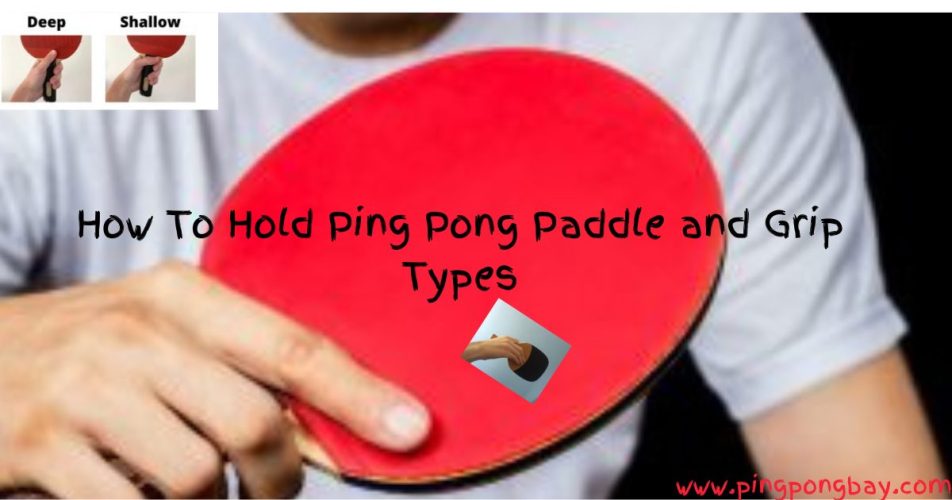In this article, we will learn how to hold a ping pong paddle and different grip types with variations. There is no doubt that ping pong is one of the most enjoyable sports in the world. Thousands of people enjoy it worldwide, whether at parties or picnics. Ping pong can be played competitively or socially, but to get the most out of it, you just need to know how to hold a ping pong paddle. We will look at some ideas. After reading this post, you will wow your friends and viewers with your grip and your overall gameplay.
After reading this post, you will be able to tell your friends how to hold a ping pong paddle and about your grip and overall gameplay. In addition to showing you how to hold the paddle, we offer comparisons of the most popular ping pong grips that will help you determine which grip is right for you.
Picking the right grip can make a big difference
You need to make quick decisions when playing ping pong so you can move forward quickly. This is the reason it is important to choose the right grip.
A well-trained person can stroke without thinking or considering their grip if they have the right grip and have good training. Your body will respond automatically when different game conditions arise.
As a beginner, you should also choose the correct grip because it’s challenging to retrain your body for a new grip once you train your body with a wrong grip or bad habits.
At first, your game can suffer, but once you learn how to hold your ping pong paddle properly, you can become one of the best. In addition to speed, control, and spin generation in-game, the right grip can transform your loss into victory.
Performing the proper grip is important for all players because the grip controls factors like:
- Paddle’s angle
- The direction of the ball
- Speed
- Depth
- Spin
Is There One Correct Way to Hold a Paddle
No, there is no one way to hold the paddle. There are multiple ways to hold the paddle, as we will see in this post. You should try to find a way that is compatible with your technique, dominant hand, and comfort. Throughout this article, we will examine the various grips there are and their variations.
Different types of Ping Pong paddle Grips
There are different types of ping pong paddle grips. Here we will cover the basics of each type.At the end of the post, you should be familiar with each type and will be aware of how to execute it while playing.
The different Ping Pong Grips are given below:
- The Shakehand Grip
- The Shallow Shakehand
- The Deep Shakehand
- The Penhold grip
- The Chinese Penhold
- The Japanese or Korean Penhold
- Reverse Backhand Penhold
The Shake Hand Grip
Shakehand Grip takes its name from the handshake position. In western countries and Asian countries, it is also known as the universal grip because it is a popular ping pong paddle grip.
Three out of four players use this grip since it offers the right amount of control over the ball.
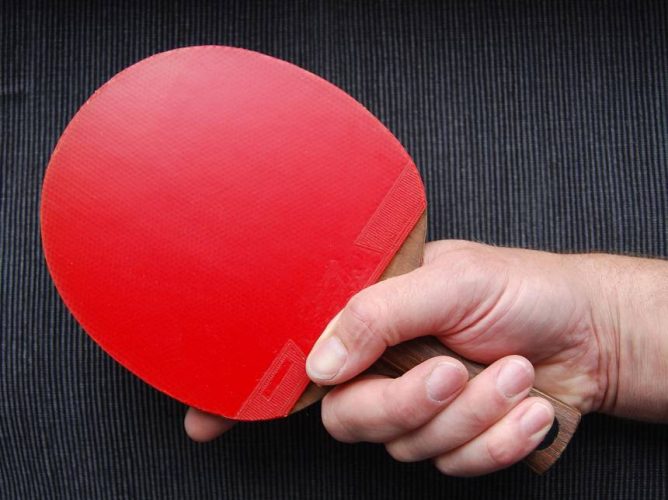
When holding the paddle with a shake-hand grip, tennis players should fold three fingers around the blade and place the index finger on the bottom of the rubber paddle edge. On the other side, the thumb should be on the bottom. Remember to keep your index finger and thumb parallel to each other as you hold the paddle. You will be able to control the storks and the ball more This type of Shakehand is quite popular, especially among beginners. Check out this post about the best paddles for beginners.
There are two types of shakehand grips in a tennis table game.
The Shallow Shakehand
This type of shakehand is quite popular among beginners.
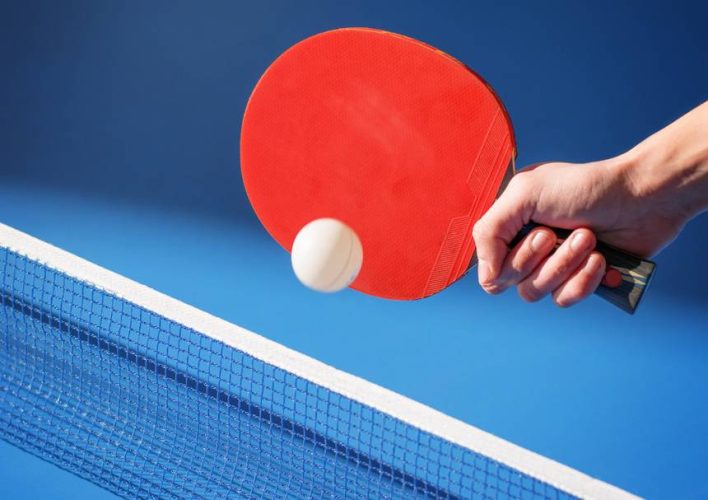
Please read https://www.pingpongbay.com/best-ping-pong-paddles-for-beginners/
In this technique, the ring finger is stretched over the bottom of the racket, and the thumb rests on the handle rather than the rubber. Three fingers on the bottom are used to wrap around the handle. Originally, the grip was achieved by holding hands with the racket, hence the name.
- Natural feeling and comfortable to hold.
- Excellent wrist flexibility.
- You can use your forehand or backhand.
- Attack power is low.
The Deep Shakehand
It is a shallow grip similar to a shake hand grip, except the hand is placed forward of the handle towards the racket’s head. The thumb is now hinged on the rubber, and the index finger is extended to the underside of the racket. You hold the handle with the bottom three fingers. This is another good way to hold a ping pong paddle.
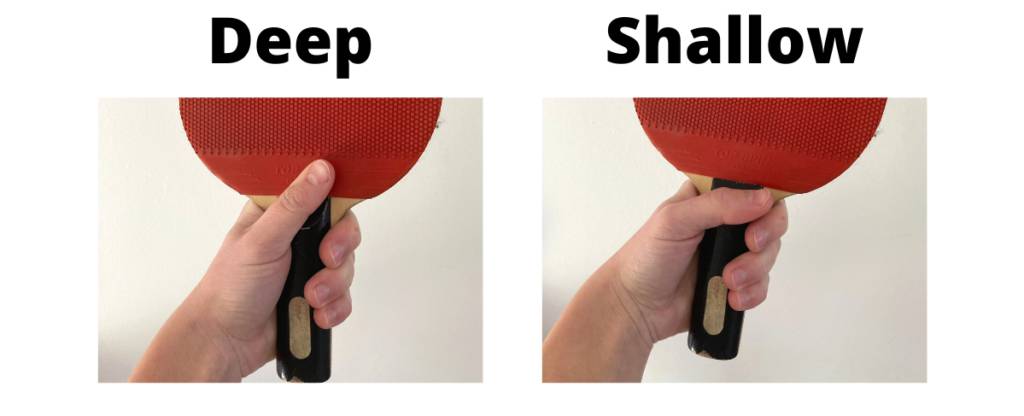
- Comfortable in hand, natural feeling.
- Forehand or backhand can be used.
- Adds power and accuracy to attacks.
- Weak crossover point.
The penhold grip
Penhold grips are the second type of paddle grip. Penhold grips are excellent techniques for beginners. This grip is based on holding the paddle handle with the index finger and thumb, and curling the other fingers around the racket handle – similar to how you hold a pen.
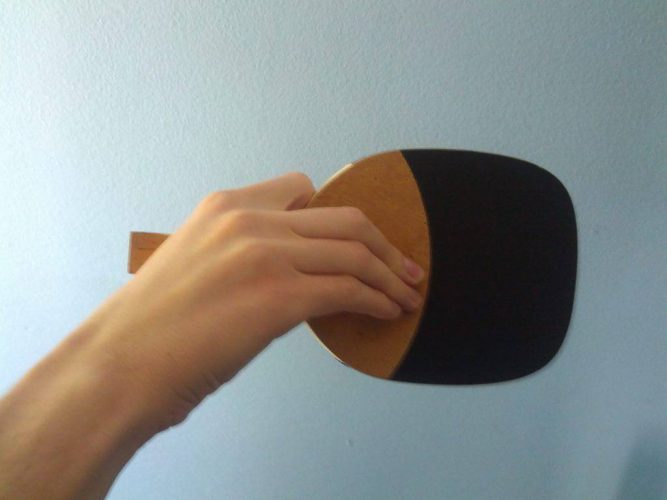
According to many users, this grip is primarily beneficial because it makes it easier to hold the paddle.The grip provides the player with an advantage on the forehand, resulting in a greater serve. Inversely, if the player is not skilled, they could have trouble on the backhand.
The Killerspin ping pong paddle is one of the best options if you enjoy the Penhold grip.
Chinese Penhold Grip
Chinese Penhold grips are the first variant of the Penhold grip. With this grip, the fingers are folded at the back of the paddle. You should use it with short, symmetrical paddles. Your serve will be more powerful since the paddle’s back is better supported.
- Excellent wrist flexibility for spinning.
- Versatile for both offense and defense.
- Topspin on the backhand is difficult to apply.
- The wrist being rotated repeatedly exhausts our body.
Japanese or Korean Penhold
In Japanese or Korean grip, we hold our thumbs and index fingers like penholders. The remaining three fingers should extend along the paddle’s back, the second finger must rest on the rubber corresponding to the blade, and the remaining two fingers stick against the second finger.
- In this grip,the fingers add strength and stability to the forehand stroke,Increasing its power.
- You can become more powerful when you have more power.
- The grip reduces blade movement, making returning the ball easier.
- It is hard to master.
Tips for choosing the right grip
Which paddle grip is better for you after considering two of the best that you can use? If you want to know which is better for you, you must look at the advantages and disadvantages.
Forehand and backhand shots feature an even distribution of power with the Shakehold grip. On the other hand, it has a wider crossover point from the forehand to the backhand.
The Penhold grip has lost popularity due to its weakness on the backhand. The player, however, can be nearly unstoppable if he/she masters the techniques. The Shakehold grip is an excellent grip for beginners. The best way to know which one is The best course of action is to try out different grips and stick with the one that you enjoy using and that improves how you play.
Penold gripping paddles have a shorter handle, while shakehand gripping paddles have a longer handle. During your swing, it is important to keep your wrists tight. Be gentle with your wrists, and consider the paddle as a part of your arm.
Keeping your grip loose will maximize your flexibility and speed. Tightening the pedals too much will limit your flexibility. It is important that you don’t restrict your movement with your grip.
Conclusion
This post has shown you how to hold a ping pong paddle. If you are a beginner, shakehand grip is easy to learn. When deciding on Grip, Choose a grip that is most suitable for you. As you choose the grip, consider choosing an affordable paddle by visiting the below site

